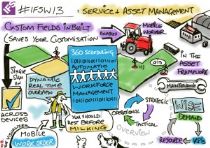This is one of a series of live blog posts directly from the site of the 2013 IFS World Conference in Barcelona. Business journalist Adam Tinworth is a veteran of Reed Business Information and a lecturer on digital journalism at City University in London. His first-hand impressions are accompanied by illustrations of Matthew Buck, cartoonist for Drawnalism.
8 reasons why you should upgrade to 8
 1. Consolidation of innovations
1. Consolidation of innovations
We deliver in many different ways, bringing all our new ideas and functionality into the system,.
2. Flexibility and configurability
Custom fields, information cards and quick charts are all ways of removing customizations. The real key thing is Custom Objects, Forms and References, that allow yo to add and work with whole new data types.
3. Mobile Solutions
They have a multitude of touch apps supporting different device types. They have mobile work orders – and warehouse data collection tools.
4. Mobile Work Order
Worth highlighting on its own. It has offline capability for use, say, in a mine. It has interfaces optimized for particular industries, and you can mix and match device types to give you flexibility.
5. Continuous Functional Enhancements
For example, they’ve added service appointment booking, and a whole new asset administration system – a 360 view of your assets, if you like. And they’re focusing hard on the usability of the document management system.
6. Utility Enhancement Package
This includes the Linear Asset system mentioned earlier – supporting transport and utility assets. GIS integration allows seamless working with map views. If you’re in construction, there’s support for asset estimating and construction planning.
7. EAM Enhancement Package
This supports a number of additional ways of organizing and administering your equipment. There’s a complete new solution for preventative maintenance across your asset lifecycle, and a brand new structure failure management module, from execution to board reporting.
8. It’s the future
The roadmap is built on this platform. All innovation is being driven by Applications 8. We’re planning on investing in mobile and user experience, business intelligence, cloud computing and global business-related issues. This all means addressing workforce planning and organization, visualizing various processes and assets, and developing ways of defining other asset types.
Scheduling Solutions
How do you control and schedule a mobile workforce? That’s what IFS 360 Scheduling is all about. It’s about optimizing plans in real time, based on data coming in from the field. You can have separate, discreet work forces all being handled by one piece of software. It does this by matching skills and time available to the jobs in the systems – alongside scenario analysis tools and visualizations that allow you to prepare for the future.
There are three types of planning:
- Strategic (the WISE system)
- Tactical (data by day planning)
- Operational (dealing with the day’s challenges)
These components are all integrated and cross-inform each other. Operational data can inform your strategic planning.
The system is sophisticated enough to manage variables like skills, locations, deadlines, available parts, and prioritising of jobs. Most importantly, you can model your planning against your committed service level agreements. Real time information from staff in the field feeds back into the system and shifts planning through the day. It takes detailed account of likely travel challenges, from road contains to the style of road between locations.
It can be deployed as a standalone product, integrated with IFS, or integrated with other systems.
WISE allows you to work with three ideas:
- Demand
- Resourcing
- KPIs
Hold two of those variable as-is, and shift the third to figure out likely impact of business changes.
The appointment booking system looks at the real time situation, and makes intelligent decisions about options for appointments based on the current situation, and is cost-aware, so it can guide customers towards the most cost efficient decision for you. It can also handle multiple visit jobs, and manage staff between them and other projects.
That’s all in 5.6. What’s due for 5.7, which is coming out next year?
- Improvement in high-density scheduling (locations like airports, power plants, housing estates and so)
- On a tactical level, the Advanced Resource Planner allows you to create provisional plans for submission and approval. This is a big request from Utilities and Oil and Gas.
- WISE’s sister, SAGE – Scheduling Automated Goal Expert. This is real-time adjustment of work to match the goals you’re in danger of missing. It will be cloud deployable.
Mobile Work Order
This is more than just an app. It works on different operating systems and devices. It operates offline, to those engineer-in-tunnel moments. It can handle big and complex data volumes, which can be synced to the mobile device.
It ties closely to the server, to maintain data integrity. The display can be highly customised to each market. The data capture templates can be defined by you, as well.
Plans for 2014
Beginning to build support for the next generation of IFS Applications, by supporting different work order types. The mobile clients will be more configurable to further reduce customisations. And greater integration options will be offered with other systems.
Right now they’re operating on Windows Mobile, Windows 7 and Android, now that security concerns have been addresses. They’ll be adding Windows 8 support next year, taking advantage of the tablet-specific interfaces it offers. That prepares the way for Windows 8 embedded support – and the internet of things.